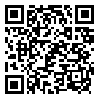Volume 80, Issue 9 (December 2022)
Tehran Univ Med J 2022, 80(9): 746-754 |
Back to browse issues page
Download citation:
BibTeX | RIS | EndNote | Medlars | ProCite | Reference Manager | RefWorks
Send citation to:



BibTeX | RIS | EndNote | Medlars | ProCite | Reference Manager | RefWorks
Send citation to:
Mousavi fard B, Sadeghi S, Shahsavaripour M. Short term effect of low-level laser therapy
on tooth stability after orthodontic treatment. Tehran Univ Med J 2022; 80 (9) :746-754
URL: http://tumj.tums.ac.ir/article-1-12035-en.html
URL: http://tumj.tums.ac.ir/article-1-12035-en.html
1- Faculty of dentistry, Kerman Dental School, Kerman University of Medical Sciences, Kerman, Iran. , b.mousavifard@kmu.ac.ir
2- Faculty of dentistry, Kerman Dental School, Kerman University of Medical Sciences, Kerman, Iran.
2- Faculty of dentistry, Kerman Dental School, Kerman University of Medical Sciences, Kerman, Iran.
Abstract: (794 Views)
Background: The purpose of this article was comparing the clinical effectiveness of low-level laser therapy (LLLT) in reducing relapse.
Methods: In this clinical trial study 14 patients (11 females and three males) who were under non-extraction treatment (MBT 022 slot) and at the finishing stage of orthodontic treatment at Orthodontics Department of Kerman Dental Faculty from April 2016 to June 2017 participated. Treatment time was two year and the patients at the finishing stage of orthodontic treatment were divided into two groups (RCT code IRCT2017053034061N1). Group 1 (study) were treated with a low-level Gallium aluminum-arsenide diode laser and group 2: control. The exclusion criteria involved patients who consumed medicine that interrupted bone metabolism and those with conditions for which laser therapy could be contraindicated. The laser apparatus emitted a wavelength of 810 nm about 50 seconds and operated with maximum power of 200 MW in continuous wave mode (200 mW, 50 seconds radiation to mesiolingual, mesiobuccal, distolingual and distobuccal surfaces, 35.7 J/cm2). An alginate impression was made from maxillary arch for all patients immediately, four, five and six months after removing the orthodontic archwire and braces and study casts were prepared. The little irregularity index of anterior maxillary arch was measured on the dental casts, with a 0.01 mm precision digital caliper. Intergroup comparisons were performed with Student's t-test and repeated measure ANOVA was perform to compare measurements among groups in different times. The significance level was considered at P<0.05.
Methods: In this clinical trial study 14 patients (11 females and three males) who were under non-extraction treatment (MBT 022 slot) and at the finishing stage of orthodontic treatment at Orthodontics Department of Kerman Dental Faculty from April 2016 to June 2017 participated. Treatment time was two year and the patients at the finishing stage of orthodontic treatment were divided into two groups (RCT code IRCT2017053034061N1). Group 1 (study) were treated with a low-level Gallium aluminum-arsenide diode laser and group 2: control. The exclusion criteria involved patients who consumed medicine that interrupted bone metabolism and those with conditions for which laser therapy could be contraindicated. The laser apparatus emitted a wavelength of 810 nm about 50 seconds and operated with maximum power of 200 MW in continuous wave mode (200 mW, 50 seconds radiation to mesiolingual, mesiobuccal, distolingual and distobuccal surfaces, 35.7 J/cm2). An alginate impression was made from maxillary arch for all patients immediately, four, five and six months after removing the orthodontic archwire and braces and study casts were prepared. The little irregularity index of anterior maxillary arch was measured on the dental casts, with a 0.01 mm precision digital caliper. Intergroup comparisons were performed with Student's t-test and repeated measure ANOVA was perform to compare measurements among groups in different times. The significance level was considered at P<0.05.
|
Results: There was significant difference among the irregularity index at five and six months after orthodontic treatment between two groups (P<0.05). In the control group except between five and six months after treatment, there was significant difference in irregularity index. The relapse was higher immediately and after four months in the laser group compared to other sequences (P=0.0001).
Conclusion: Sample showed that Low-level laser therapy (LLLT) is a non invasive method for reducing relapse after orthodontic treatment. |
Type of Study: Original Article |
Send email to the article author
| Rights and permissions | |
 |
This work is licensed under a Creative Commons Attribution-NonCommercial 4.0 International License. |





